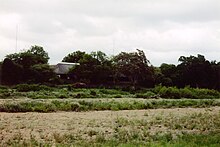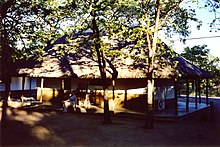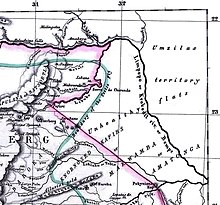Shingwedzi
To the immediate east Soshangane established himself as overlord of the lower Bileni/Limpopo valley from 1827/28 to 1835,[6] displacing resident Tsonga people in clashes like the Battle of Xihaheni, while moving northwards.
[8] In December 1902, Leonard Ledeboer, a Zoutpansberg resident who had switched sides during the war, suggested the establishment of a reserve to sir Godfrey Lagden of the Department of Native Affairs.
The reserve boundary went from the Groot and Klein Letaba confluence in a straight line north to Shikumdu Hill, turning northeastwards to the Levuvhu and Crook's Corner.
They had apparently exterminated all the elephant, rhino and eland during the war, and regarded game laws and ordinances as "waste paper", while having "no sporting instincts and no sense of honour as a rule".
[8] The eccentric, red-bearded Fraser was recruited from Scotland as ranger for the small Pongola Reserve (dissolved in 1921),[7] before he was transferred to Malunzane (also Malundzane) in Singwitsi.
This he named Punda Maria, perhaps a playful corruption of phande mariha (or "border of the winter"), the alleged Venda appellation for this region.
[10] When Stevenson-Hamilton returned from Sudan to South Africa in 1920, he observed that a depressing retrogression had occurred in terms of discipline, management and faunal preservation in both the Sabi and Singwitsi Reserves.
[7] The persons involved in the Kruger Park's creation, the extent of their contributions and their political motives are matters of debate, but may be seen as the culmination of various protectionist movements and many strands of thought.
The Kanniedood Dam was constructed 9km downstream of the camp in 1978, but was demolished 40 years later, in 2018, in line with a rehabilitation project which aims to limit artificial water points for animals.
Rare herbivore species such as roan suffered due to increased grazing competition by abundant grazers,[14] and from predation by lions which likewise expanded their territories.
[4] Heavy rains are normal at the start of each year, which may affect tourist roads, bridges, picnic spots and bush camps.
These levels were surpassed on 20 January 2013 when Shingwedzi and Sirheni camps were completely submerged by flood water[18] after 400 mm of rain in a week caused the Mphongolo and Shingwidzi Rivers to burst their banks.
[22] Ranger D. Swart reported seeing a group of six bat-eared foxes near Shingwedzi in 1967, a species previously thought to be restricted to the western parts of southern Africa.
[17] Two bird species represent the southwesterly arid fauna however, namely the fawn-coloured lark and Kalahari scrub robin, which both occur in the elevated sandveld around Machai Pan.
[25] The immediate vicinity of Shingwedzi camp contains some riparian vegetation with large trees, and narrow alluvial plains created by centuries of flooding, flank the river on each side.
In 1999 chief Shilungwa Mhinga claimed all land in the park north of the Shingwedzi River, and intended to use the southern portion for ecotourism hotels and other parts for lodges.


